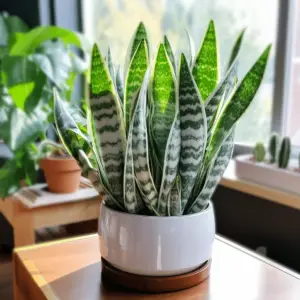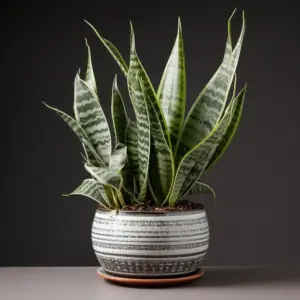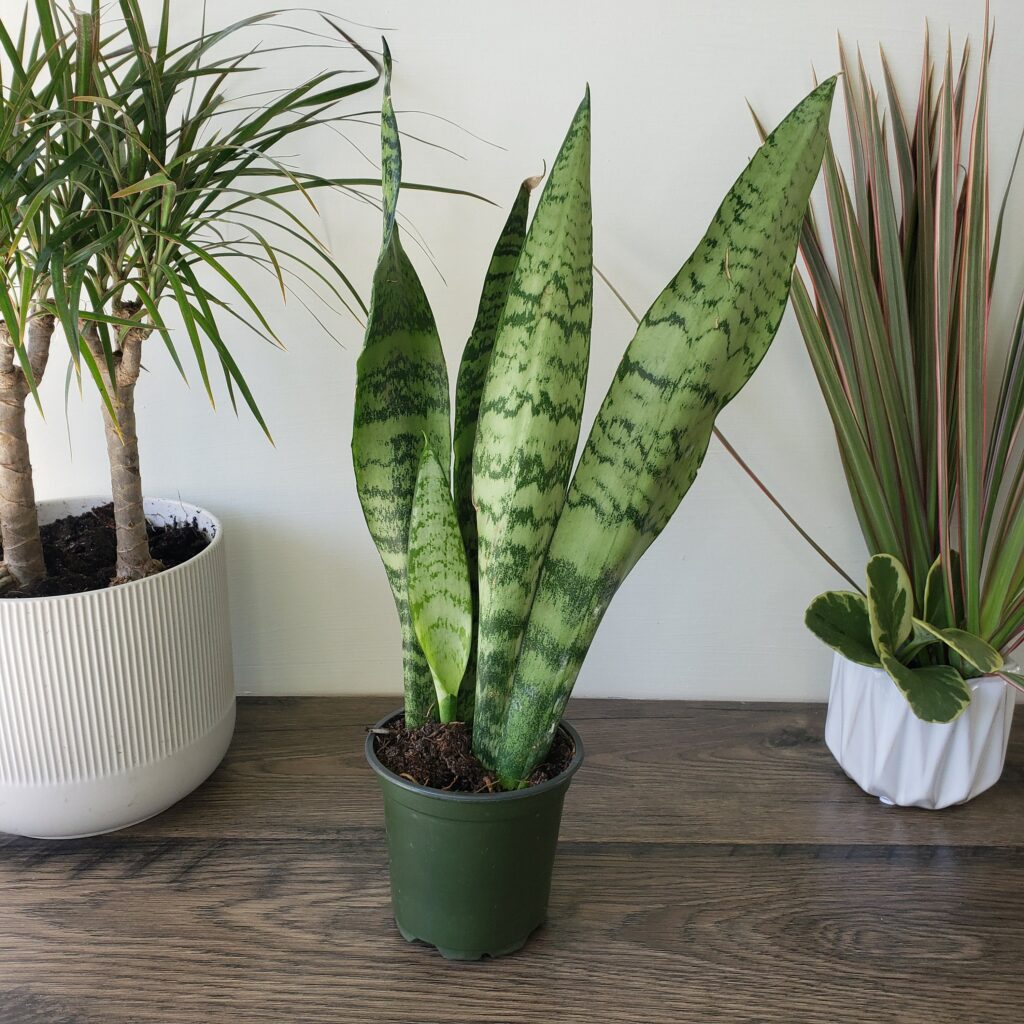Sansevieria Silver Queen Moonshine Care, is one of the hardiest varieties of sansevierias, and the least expensive.
It is also one of the most common varieties to be found growing in healthy conditions around homes, offices, and hospitals.
It is often used as a houseplant (especially in offices) because it requires very little care, grows slowly, and stays relatively small even when provided with little or no pruning.
Typically, it can easily survive for many years, although the growth rate of the plant is very slow.
Table of Contents
Sansevieria

Sansevieria is a genus of flowering plants predominantly found in Madagascar and parts of Southern Asia.
Commonly referred to as snake plant, Sansevieria plants are also called mother-in-law’s tongue, jinn’s tongue, bow string hemp, snake tongue and devil’s tongue among others.
There are over 70 unique species within this genus each varying greatly in characteristics based where they grow.
Sansevieria trifasciata Species
Also known as Dracaena trifasciata, this species is largely found in West Africa, Nigeria.
It can be described generally as an evergreen shrub with a compact central rhizome that sits under or above ground, from which its leaves shoot vertically in dense rosette or circular formations.
It is a dry weather plant well adapted to desert conditions, that typically does not exceed a meter in height. Both Moonshine and Silver queen are varieties or cultivars of Sansevieria trifasciata and not singular species.
Cultivars
A cultivar is a plant that has been bred for specific desired characteristics. Most cultivars are the result of purposeful human intervention but some cultivars can emerge naturally.
There is no standard nomenclature for cultivars since the possible variations are infinite but the common variations are accepted as uniquely identifiable plants.
Sansevieria trifasciata has a host of cultivars. Silver queen is one of the most coveted and readily available variety with Moonshine being very rare.
Shared Traits of Sansevieria Silver Queen and Moonshine Varieties
- Both Moonshine and Silver queen today are cultivated for beauty and ornamental value decorating both offices and homes with a distinctively classy, tasteful atmosphere which speaks of refined, tempered predilections.
- Both have other benefits such as air purification but the rate at which they absorb toxins from the air is too slow to be a quantifiable benefit as indoor plants.
- As decorative plants, they require minimum care and do very well in warm and hot climates. Winter conditions render them almost dormant and they are susceptible to scarring under low temperatures.
- They will rot and die off if watered frequently. They are succulent dry weather plants which means they store sufficient amounts of water in their leaves.
- They both grow best in tight or small gardening pots that can be switched for larger ones over time to accommodate their robust roots.
- Both Moonshine and Silver queen are mildly toxic to humans and animals so keep them away from children and pets.
Silver Queen and Moonshine Varieties
- These varieties are tough and do not attract infestation by pests. Spider mites and mealy bugs sometimes attack but can be managed quite easily by sprinkling ash on the leaves of the plant or using a simple pesticide if the infestation is advanced. Keeping the soil dry is key to avoiding infestation. Ensure the plants are positioned so that no moisture or water settles on them.
- Moonshine and Silver queen are best planted in soil mixtures and not 100% soil, which will retain too much moisture for these plants. Plant in mixtures of soil and sand, perlite, coir, gravel or get potting mixtures made for succulents. These mixtures will drain excess water and keep the roots of your plant dry and well aerated.
- Both plants are perrenial and are expected to last between five and ten years. Most of these plants, however, have been known to go up to 25 years. They grow very slowly which is another reason they make such excellent decor items.
- It is quite easy to grow and propagate succulents and both Silver queens and Moonshines are propagated the same way. Seeds are rare and planting directly from the seed could take quite sometime. It is more practical to propagate them from the leaf or root cuttings of a mature plant.
Moonshine Varieties
- When using leaf cuttings, simply cut 2 – 3 inches from a larger leaf and place a quarter of it in water. Once the roots begin to show, repot the plant in potting soil.
- Alternatively, cut 2 – 3 inches of a large leaf and let the leaf dry out for two days. Plant the leaf in potting soil made for succulents.
- Using root cuttings is the easiest and fool proof way to propagate them. Simply uproot a mature plant that has a well developed root or rhizome and cut a piece less than a third of the rhizome. Replant the succulent back and plant the root cutting or cuttings you have made in separate gardening pots. Llet them shoot.
Differences between Silver Queen and Moonshine

Silver Queen
- The main difference between Silver queens and Moonshines is their appearance and foliage. Sansevieria Silver queen is a beautiful plant which, as the name suggests, has a silver – greyish hue on the pale green leaves. Its leaves are long and narrow shooting vertically from the rhizome to form a foliage of tightly packed leaves.
The Silver queen variety is the one most commonly referred to as snake plant because of the patterns on its leaves. There are pale irregular shaped green streaks all across the long sword shaped leaf.
The leaves can grow up to 3 feet in height and they are approximately 1.5 – 2 inches wide.
- Silver queens flower irregularly and on the extremely rare occassion that they do, the flower emerges as a separate stalk directly from the rhizome. The small white flowers grow in clusters on the stalks. In most cases flowering occurs in the winter though winter can pass without Silver queens flowering.
Moonshine
- Sansevieria Moonshine is a smaller majestic plant with a more modest picture. Its leaves are thickly robust and wide sporting a silvery green hue. The wide tongue shaped leaves bear a dark green boundary all around and usually grow in groups of three directly from the rhizome.
Young or new leaves are white in color and under ideal conditions, the leaves can get up to 2 feet in length though this is not common. The width of the leaves is about 4 – 5 inches at the widest parts.
- Moonshines flower more frequently compared to Silver queens especially if they are placed where they can access moderate morning sun. Flowers are white with a pleasant but light fragrance which does not overwhelm.


